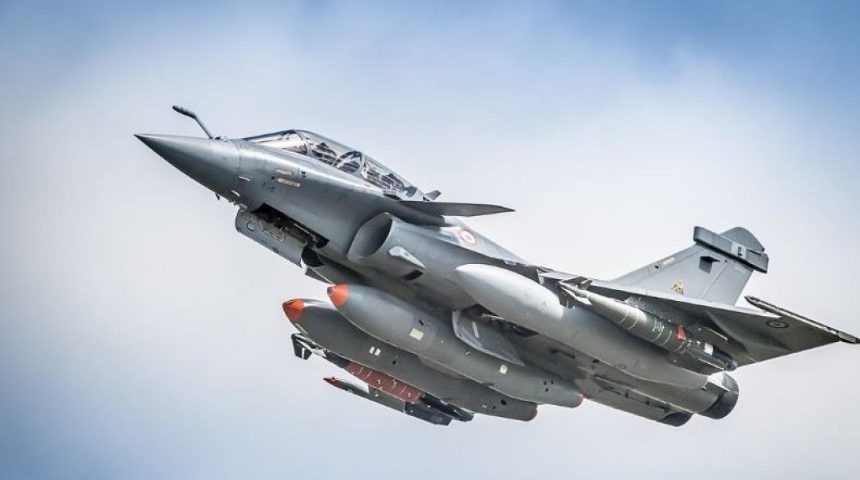The new standard brings major capability upgrades which pave the way for collaborative air combat.
The French Directorate General of Armaments (DGA) announced that the new Rafale F4.1 standard has been qualified and is now ready for fielding. While the announcement was released just few days ago, the qualification arrived on March 13, 2023, shortly after the first aircraft in the new configuration was delivered to the Base Aérienne 118 at Mont-de-Marsan.
“The first plane we received is one of the F3Rs that we sent to the Flight Test Center of the Directorate General of Armaments, in Istres, for their software transformation”, explains Lieutenant Colonel Guillaume, second in command of the Fighter and Experimentation Squadron (ECE). “Other brand new aircraft will come directly from the Dassault production lines, and will complete the fleet of fighters sent gradually to Istres for their transition from the F3R standard to the F4.1.”
The first Rafale F4.1 has been assigned to the Centre d’Expertise Aérienne Militaire (Military Air Expertise Center), followed by a second aircraft a week later, where it immediately started operational testing the day after the delivery. As mentioned by Lt. Col. Guillaume, the DGA confirmed all the Rafales of the Air and Space Force and the French Navy will be gradually retrofitted to this new standard. Dassault also resumed the deliveries of new Rafales to French military, after a four-year interruption.
The development of the Rafale F4 standard started in early 2019, when the contract for the new upgrade was notified by the Ministry of Defense soon after the certification of the F3-R standard. “This standard is based on four pillars: connectivity, engagement, availability, and the detection and fight against threats,” said the Minister of the Armed Forces in that occasion. “This F4 standard is a technological leap, an industrial leap, a strategic leap.”
According to the DGA, improving the connectivity of the Rafale and the associated networked employment methods, both in a national and allied context, is the primary goal of the F4 standard. The new standard will be the first step towards the networked multi-platform capabilities of the future Système de Combat Aérien Futur (SCAF).
The F4 standard will include upgrades of existing capabilities, like the Thales RBE2 Active Electronically Scanned Array (AESA) radar, the Spectra (Système de Protection et d’Évitement des Conduites de Tir du Rafale or, in English, Self-Protection Equipment Countering Threats to Rafale Aircraft) electronic warfare system, the OSF (Optronique secteur frontal/ frontal sector optronics), the InfraRed Search and Track (IRST), the Thales Talios targeting pod, the Reco NG reconnaissance pod and the communications suite.

However, there will also be important new capabilities, like the Thales Scorpion Helmet Mounted Display (HMD), the MICA NG (Next-Generation) air-to-air missile and the new 1000 kg variant of the Safran AASM (Armement Air-Sol Modulaire) “Hammer” Precision-Guided Munition (PGM). Many of the new capabilities have been extensively tested during a test campaign in 2021, where two Rafale 4.1 were included in large-scale realistic scenarios, where the crews also implemented unspecified collaborative combat functionalities to localize adversaries by passive means.
The HMD is a long-waited capability for the Rafale. Initially, the Sagem Gerfaut HMD was chosen in the early 2000s to equip the Rafale, however the program was later dropped. According to reports, Qatar and India asked for an HMD on their aircraft, so the Elbit Targo II was integrated on the Rafale. France, however, chose to integrate the Scorpion, with a first test campaign carried out in Cazaux during March 2021, preceded by parachute compatibility tests to verify that the new helmet is safe for the pilot in the event of an ejection.
As for the 1000 kg AASM, the new variant sees the AASM kit applied on the BLU109 penetrator warhead or the standard Mk-84, but also to new developments in progress from the French company ARESIA (BA84 and P1000 bomb bodies), according to the mission’s needs. The first separation tests were performed in December 2020 at the DGA Flight test center in Cazaux.
The new AASM variant has have also a specific range increase kit to extend its stand-off firing range and was certified at the end of 2022. The Rafale will be able to carry up to three of these bombs, of which one under the fuselage and two under the wings, similarly to the already certified GBU-24 Paveway III.
The Talios targeting pod has also been upgraded, as announced by the DGA in November 2022 with the delivery of the 31st pod, which is the first of the upgraded variant. Among the new capabilities, the pod has a high-definition mode, which integrates a near infrared imager and a color wide-field sensor (expected to be fully exploited by the Rafale 4.2 standard), and an integrated datalink.
Among the other modifications, the DGA mentioned the evolution of passive threat detection algorithms, increased data exchange capacities between Rafales, greater protection against cyber threats and improvements in fire control for the use of the Meteor missile, with the missile managed by an aircraft other than the firing aircraft. The Meteor missile was introduced with the F3-R standard and became operational in 2021, intended to be used in conjunction with the MICA EM for long range engagements.









